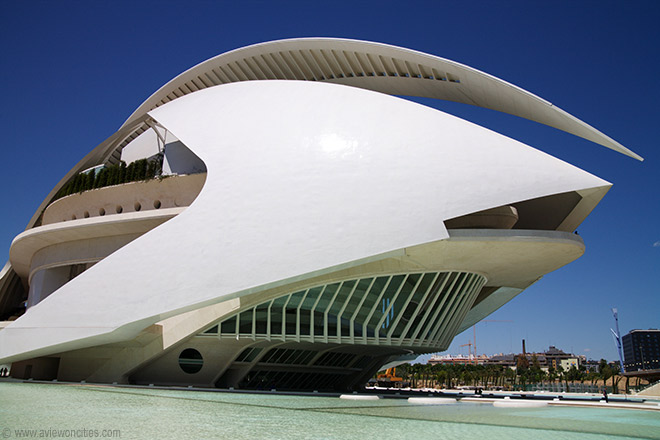Palau de les Arts Reina Sofía (Queen Sofia Palace of the Arts)

A nation's identity can be shown through a built environment, for instance : when we talk about China, we remember about the Great Wall. When we talk about Cambodia, we remember about Angkor Wat. When we talk about England, we also remember about the London Bridge. In this post, I want to talk about Palau de les Arts Reina Sofía.
Palau de les Arts Reina Sofía is an opera house and also a cultural center in Valencia, Spain. Palau de les Arts Reina Sofía is designed by the Valencia-born and internationally known architect, Santiago Calatrava which using the contemporary concept on the design of this building. The process began in 1995 and it was opened on 8 October 2005. And the first opera that is presented in that theatre is Beethoven’s Fidelio, at October 25th 2006.
Measuring over 70 metres in height, the Palau de les Arts is divided into four separate halls, all boasting the latest technological advances conceived to stage all kinds of opera, musical and theatrical performances.
Under the expansive curved-roof structure, 230 metres in length, the building rises fourteen stories above grade and includes three stories below ground. Its height is 75 metres. The 40,000 sq. metre building contains four auditoriums:
· The Sala Principal (Main Hall)
Designed to seat more than 1800, it will be used for opera, zarzuela, classical ballet, contemporary dance, symphonic music, musicals and theatre. The Hall has four tiers of seating, a stage equipped with all major facilities, and the third largest orchestra pit in the world, being capable of housing 120 musicians. The main Hall is at the heart of the building, both formally and structurally speaking.
The building suffered a number of unfortunate incidents after its opening which hampered initial productions. The first of these was the collapse of the main stage platform while it was bearing the complete set of Jonathan Miller's production of Don Giovanni in December 2006. This forced the Palau to cancel the last performance of La Bohème, all of La Belle et la Bête, and meant that the management had to reschedule the remainder of the inaugural opera season. In November 2007, the entire cultural complex suffered a series of floods. The recently re-built stage platform was paralised once again because almost two metres of water entered the lower floors of the building and wrecked the electronics and the motors of the complex stage equipment, forcing the management to re-schedule the season again, delaying the premiere of Carmen and canceling the opera, 1984.
· The Auditorio
Located above the Main Hall. It seats 1,500 people and its facilities include sound and video systems capable of projecting displays of events taking place in venues below it. Officially given to the managing trust during the 2007–2008 season, it is a spectacular venue with multiple uses, from classical music concerts to political rallies.
· Aula Magistral
Capable of seating 400 people and is used for chamber music performances and conferences.
· Martí i Soler Theatre
Constructed below the base of the Palau's plume and seats 400 people. It shall be used for theatre productions and as a training centre for the main auditoria. Unfortunately, this hall suffered vast damage during the 2007 flooding and its opening was delayed. No equipment had been installed before the flooding, however, so the estimated cost for reconstruction was much lower than it would have been shortly thereafter.
From what I explain above, I can conclude that this building is an attractive building. I think this building can also increase the popularity of the city where this building located, Valencia. What do you think?
Some Elevation of Palau de les Arts Reina Sofía



Art Performance in Palau de les Arts Reina Sofía

Sources :
http://www.valencia-cityguide.com/tourist-attractions/monuments/palau-de-les-arts-reina-sofia.html
http://en.wikipedia.org/wiki/Palau_de_les_Arts_Reina_Sof%C3%ADa#The_building
Compiled by : William Chandra